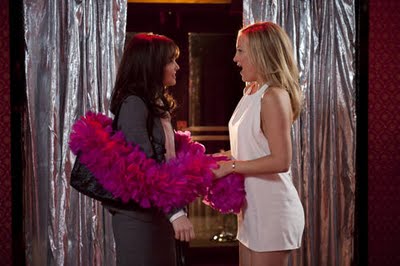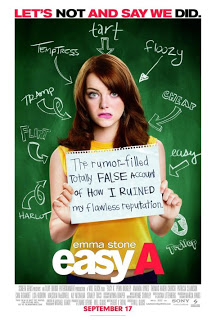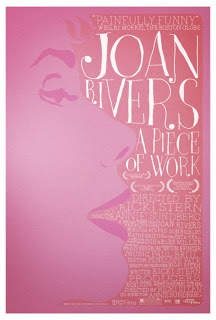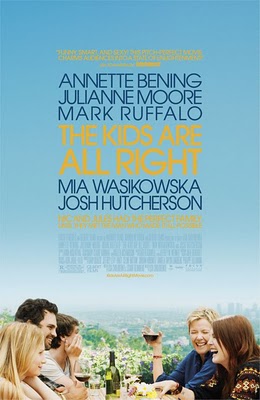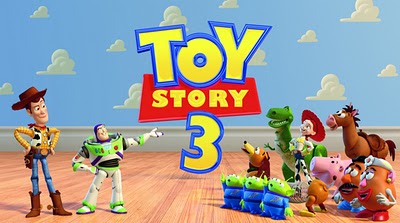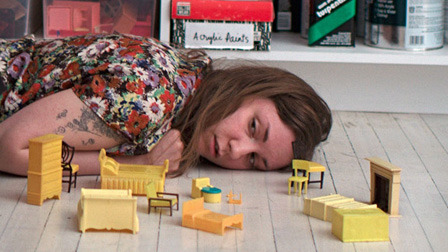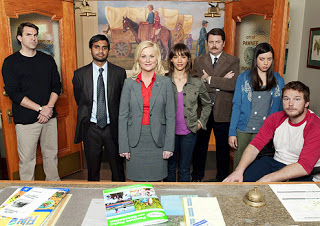Tag: Comedy
Tangled: A Feminist Film Review
This guest review by Whitney Mollenhauer first appeared at Not Another Wave in December 2010.
- Rapunzel’s father (the king) cries on Rapunzel’s birthday as he remembers his kidnapped daughter. It seems like usually in these kind of movies, you see the mom crying and the dad consoling her; but here, it’s the other way around. Win! Men can express emotion, too!
- Rapunzel sews and bakes, but she also reads, does astronomy, and paints like no other.
- She is so awesome with her hair! She ties the male protagonist up, lets herself down from the tower, and climbs everywhere. Seriously, it’s very impressive. She can do just about anything with that hair–it’s not just for show.
- Rapunzel ends up with short hair! Okay, that’s just a little thing, but have you ever seen a Disney princess with a pixie cut before? Even Mulan had longer hair!
- So yeah, the mom is the bad guy because she’s vain/wants to be young forever, blah blah blah. But I don’t know how they could have had a male villain or some other way for the mom to be the villain without straying too far from the original. But at least she gets some jokes.
- The frying pan proves to be a superior weapon compared to the sword! This might be getting a little too psychoanalytic, but I saw the frying pan as symbolizing a kind of feminine/transgressive power, while the sword represents traditional masculine power. I just thought it was neat. You don’t have to be a swashbuckling dude to kick butt.
- Her story and her adventure starts not because the guy “whisks her away” or something; but rather, she plans and schemes: she catches him breaking into her tower, and strategically decides to use him to reach her goal of seeing the flying lanterns on her birthday.
- Spoiler alert: in the end, she’s not “saved” because of her compassion, but in spite of it–her compassion might actually have been her downfall. Unlike other movies/fairy tales where a woman’s only redeeming quality is self-sacrifice, this ending suggests that self-sacrifice isn’t always such a good thing–or at least that it’s not solely the domain of women. Men can be self-sacrificing too! (Didn’t want to reveal too much here. Go see the movie if you want to figure out what on earth I’m talking about.)
- I liked the ambivalent nature of how it shows her mom’s and her relationship when Rapunzel leaves the tower for the first time. She feels guilty, but MAN is she happy and excited and brave!
- She doesn’t get married at age 18!!!!
- In my opinion, the relationship was not even really a central feature of the story, but rather a sub-plot. The main plot was getting away from her mother, figuring out her actual identity, getting to the flying lanterns she wanted to see.
- I felt like it was good and feminist because it was a major improvement from how Disney usually is. Also, overt sexism did NOT distract me from what was otherwise a visually appealing, witty movie (as it usually does). And that is really saying something.
- Even the rich, hypermasculine stereotype is challenged–the male protagonist reveals his true name/identity, as an orphan, and she says she likes him better than the fictional (hypermasculine) character that he aspires to be like.
- In the end, I think it makes a good case for women’s “proper place” NOT being just in the home, but out in the world/public sphere! I’m not sure how you could get any other moral out of it. Even in Mulan, after she saves China, she ends up returning home, and (we suspect) marrying the army captain guy, instead of taking a job with the emperor. In Tangled, the movie’s premise is centered around the idea that it’s wrong and horrible to expect a woman to spend her whole life at home.
- When the male protagonist breaks into her tower, she kicks his butt; she stands up for herself in the bar; and she stands up to her mother in the end (about having been kidnapped).
- At the end of the movie, SHE dips HIM and kisses him. (I always hated it when guys would dip me. If I want to kiss you, I am going to kiss you, so just let me stay on my own two feet.)
- Body image stuff: Okay, so Disney’s not breaking down any boundaries here. Also, infantilization much? Rapunzel’s face is that of a two-year-old.
- So, I’m not very good at remembering specifics, but I DO remember not getting angry at seeing her needing rescuing again and again and again. It seemed like mostly she was able to save herself, and the guy didn’t save her a whole lot.
- In the bar, Rapunzel and the guy (Flynn) meet a whole bunch of rough guys. They sing a song about how everyone’s got a dream: the one tough guy says to Flynn, “Your dream stinks,” referring to his dream of getting rich. The other tough guys have dreams of becoming mimes, finding love, being a pianist, becoming a baker–and one made little tiny unicorns. Even tough guys have nuance and feminine qualities!
- Rapunzel’s animal companion is Pascal the chameleon. Pascal is super cute, and is possibly named after Blaise Pascal the mathematician (suggesting that Rapunzel is a math nerd like me, though that could just be me reading too much into it). Pascal can’t talk, and I felt like that was a good thing (feminist-wise), so he couldn’t show her up and become the hero (remember Mushu the dragon in Mulan?)
Guest Writer Wednesday: Easy A: A Fauxminist Film
 |
| Emma Stone stars in Easy A |
The Flick Off: Bored to Death
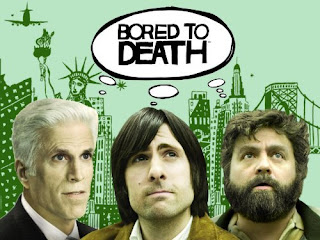 |
| The first season of HBO’s Bored to Death |
Honestly, the last thing we really need is another show about white male hipsterism. Set in Brooklyn? Check. Protagonist is a whiny artist type? Check. Whiny artist-type best friend? Check. Kooky outsider friend? Check. Bromance-style hijinks? Check. One-dimensional women? Check. Women who inhibit the protagonist and his best friend? Check. Money not an issue? Check. You get the picture, right?
Don’t get me wrong: Ted Danson is very funny in this show, even if he is just playing a less-evil Arthur Frobisher (from the fantastic Damages), replacing coke-fueled corporate crime with pot-fueled magazine-editor slickness and humor. That’s about the only compliment I can give this snooze-fest.
The premise of Bored to Death is a bit weak, yet has potential: With nothing else to do besides write his second novel, character Jonathan Ames (named by real-life writer Jonathan Ames, played by Jason Schwartzman) offers himself for hire on Craigslist as an unlicensed investigator. Jonathan only drinks white wine now since his girlfriend henpecked him about drinking, he’s really sensitive, and, come on, he’s a lovable hipster. FEEL SORRY FOR HIM! The fact that his cases are small and insignificant (the case of the stolen skateboard, finding a woman whose workplace and stage name are already known) isn’t the problem; the problem is that they mean nothing. Jonathan is such a boring person that he investigates other people’s problems to mine them for story ideas, since, you know, he’s blocked and his second book is due. At least I think that’s why he’s doing it. Also, it’s a semi-interesting way to procrastinate (it could be a hilarious way to procrastinate, but the show rarely, if ever, reaches those heights). Another HBO show, which shares the premise of an unlicensed detective investigating often small crimes, The No. 1 Ladies’ Detective Agency, has purpose and smarts. This unlicensed detective show is all about the ego of Jonathan Ames.
Here’s the real reason for the flick off: the women are awful. They aren’t bad people—we’re not dealing with the galling misogyny of Hollywood blockbusters here—but they’re so lazily written that I can’t believe HBO, usually so keen on characters, greenlit this show. Bored isn’t interested in who its female characters really are, as its main characters aren’t interested in anything but their own egos. Ray (Galifianakis) complains about his girlfriend’s obsession with their lack of intimacy, and she regularly suggests ridiculous solutions, including Ray getting a colonic, Ray going to therapy, and Ray giving her timed massages—yet she still gives him “an allowance” so he has money for essentials like weed. Jonathan’s ex-girlfriend, whom he is still obsessed with, seems to exist only to walk her little white dog while wearing gorgeous lady-hipster outfits and torture him with her beauty of lack of love for him. Guest stints from very funny actresses—including Parker Posey, Kristin Wiig, Jenny Slate, and Bebe Neuwirth as Jonathan’s editor–are utterly wasted. (As is Zach Galifianakis, actually.) These women aren’t there to be funny, or, you know, be people; they appear mostly as male fantasies (smart, beautiful women who would have anything to do with Jonathan and Ray) and nightmares (underage, duplicitous, blackmailing, domineering, hysterical, criminal, etc.)
Every time an interesting concept comes up, the show detours so as to not actually have to deal with said interesting concept. A character doing this would be fine and fitting; the show doing it tells me that the writer (ahem, Ames) is too close to the characters and show. For example, Ray agrees to donate his sperm to a lesbian couple, only to learn that the couple gave him fake names and sold his sperm to twenty-one other couples. This is a funny set up (if you can get past the evil lesbian trope)! So, Jonathan and Ray totally investigate the case, figure out who these women are, and run into all sorts of funny trouble on the way, RIGHT? Um, no. They happen upon a list of women who bought the sperm, and visit these women to see if any are pregnant. One is. Ray is happy? What? Huh? End of episode. What? Yeah, that’s about it.
You might wonder why I even watched the show, knowing it centered on privileged white male characters who think they are funnier and more interesting than they actually are. Good question. I guess I retain hope that such a show might be well written and funny. That maybe such a show could be a humorous examination of characters like these, instead of a blindly sympathetic ego trip. I’m open to giving a lot of things a chance, when maybe I should just skip them. I don’t want to be cynical, though, and HBO has a way of surprising us with its programming. (Take The Sopranos as an example: this show is an indictment of the American upper-middle class, disguised as a show about a mafia family. Granted, it has its own problems, but I never expected to like it as much as I did.)
Bored to Death is ready to begin its third season. Since it is still on the air, I hope it has improved from the first season I watched on DVD. I can’t say I’m optimistic, but since I don’t have premium cable, you might know better than me. So, what did you think of season one? Have you watched subsequent seasons/episodes? What do you think?
Documentary Review: Joan Rivers: A Piece of Work
 |
| Joan Rivers: A Piece of Work |
Watching the film, however, gave me a new appreciation for Rivers–even while not sharing a number of her perspectives. A Piece of Work documents a year in Rivers’ life: she turns 75, faces down a heckler at a stand-up show in Wisconsin, honors George Carlin in a tribute, gets roasted by Comedy Central, and injects new life into her career by winning Celebrity Apprentice. All while still selling that damn jewelry. Her energy level is astounding, and I wonder how she manages to do all she does at the age of 75.
Rivers is an odd character. Being a superstar female comic alone is odd in the U.S.–only a few came before her–but we get a very real look at her life, at the troubles she has faced (her husband’s suicide) and continues to face, and at the loneliness that certainly helps her drive to fill her daily calendar. She is vulnerable and still nervous when going on stage, especially when pursuing what she calls the one sacred part of her life–her acting–in which she hasn’t seen a lot of personal success. I came to find her more compelling and interesting than my initial perception of her, and encourage anyone to see this film and learn more about a woman who refuses to stop.
Guest Writer Wednesday: Bridesmaids Preview
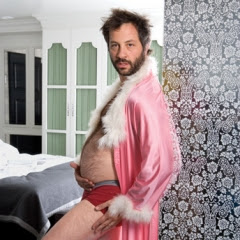 |
| Judd Apatow puts on some panties in Bridesmaids |
Having turned 18 at the birth of the Sex and the City era, college and adulthood came at a time when sexual expression and alcohol could be worn like Girl Scout badges, proudly and with accomplishment. It was the best of times (that I could remember) and the worst of times (that were gladly hazy). The graduates of the millennium celebrated leaving the sophomoric comedy of American Pie and blissfully embraced the gratuitous ass shots of Will Ferrell. And just as quickly as we got on “double-secret-probation” in college,” we just as quickly matriculated from it. Now working stiffs and pissed off about having $160,000 in college debt, Judd Apatow appeared to ease our pain with raunchy and outrageous humor.
 But then my heart sank as I read about the other comedy he’s producing, unimaginatively called Bridesmaids (release date May 2011). Written by and starring Kristen Wiig, the movie is about “a maid of honor trying to please the snobby, eccentric or really awkward bridesmaids at every pre-wedding event before her best friend’s nuptials.” Given Wiig’s successful comedic record, it’s clear she can hang with the funniest of dudes, and I’m willing to bet she lays down some solid jokes in Bridesmaids, but that type of movie has graced the big screen before with lamer jokes and interchangeable blondes and brunettes – cue the bridezilla, bridesmaid dress fat jokes, Vera Wang and a heart warming, seen-the-error-of-our-ways ending.
But then my heart sank as I read about the other comedy he’s producing, unimaginatively called Bridesmaids (release date May 2011). Written by and starring Kristen Wiig, the movie is about “a maid of honor trying to please the snobby, eccentric or really awkward bridesmaids at every pre-wedding event before her best friend’s nuptials.” Given Wiig’s successful comedic record, it’s clear she can hang with the funniest of dudes, and I’m willing to bet she lays down some solid jokes in Bridesmaids, but that type of movie has graced the big screen before with lamer jokes and interchangeable blondes and brunettes – cue the bridezilla, bridesmaid dress fat jokes, Vera Wang and a heart warming, seen-the-error-of-our-ways ending.Best Picture Nominee Review Series: The Kids Are All Right
“‘That Nic and Jules are a lesbian couple is important to the movie thematically because they are raising a family in an unconventional setting and are more anxious than some parents about how having two moms will affect the mental health of their children. But it could have been the same thing with a divorced couple,’ she says. ‘I always thought we were making a movie about a family, and the threat to the wholeness of the family. It was not about politics. If there was anything calculated, it was how do we make this movie universal — how do we make this a story about a family?'”
“‘Lesbians love it when a married woman has an affair with another woman on film, which is perceived as moving toward authenticity, but we’re not happy seeing a woman in a same-sex marriage have an affair with a man, which to them represents a regression. And raises concerns about whether it adds fuel to the notion that sexual orientation can be changed from gay to straight. Sitting in the audience, I found myself feeling concerned about that as well…'”
“‘It boils down to this: I’m upset because I believe the takeaway from this film will be that lesbians and the families they create need men to be complete.'”
“‘Your mom and I are in hell right now and the bottom line is marriage is hard. It’s really fucking hard. Just two people slogging through the shit, year after year, getting older, changing. It’s a fucking marathon, okay? So, sometimes, you know, you’re together for so long, that you just… You stop seeing the other person. You just see weird projections of your own junk. Instead of talking to each other, you go off the rails and act grubby and make stupid choices, which is what I did. And I feel sick about it because I love you guys, and your mom, and that’s the truth. And sometimes you hurt the ones you love the most, and I don’t know why. You know if I read more Russian novels, then…Anyway…I just wanted to say how sorry I am for what I did. I hope you’ll forgive me eventually…'”
Best Picture Nominee Review Series: Toy Story 3
Out of seven new toy characters at the daycare where the majority of the narrative takes place, only one is female–the purple octopus whose scant dialogue is voiced by Whoopi Goldberg. Although two of the toys in the framing scenes with Bonnie, the girl who ultimately becomes the toys’ new owner, are female, the ratio is still far worse than the average in children’s media of one-female-to-every-three-males (documented by The Geena Davis Institute on Gender and Media). And these ratios have a real effect: Decades of research shows that kids who grow up watching sexist shows are more likely to internalize stereotypical ideas of what men and women are supposed to be like.
Toy Story’s latest installment revolves around now-17-year-old Andy leaving college. His mom (who has yet to be given a name) insists (in rather nagging fashion) that he store or get rid of all his “junk.” The bag of toys mistakenly ends up in the trash, resulting in the toys landing in a prison-like daycare (way to turn the knife on working parent guilt).
In typical Pixar fashion, male characters dominate the film. Though it ends with young Bonnie as the happy new owner of the toys, making way for more sequels, Woody would have to become Wanda, and Buzz become Betty, in order for the series to break Pixar’s male-only protagonist tradition (think Wall-E, A Bug’s Life, Cars, Monster, Inc, The Incredibles).
Bo Peep is inexplicably missing in this third installment, leaving even fewer female figures. Barbie has a larger role this time around though, as an overly emotional, often crying girlie-girl. She is also a traitor of sorts, breaking away from the gang to go live with Ken in his dream house.
As for Ken, he is depicted as a closeted gay fashionista with a fondness for writing in sparkly purple ink with curly-Q flourishes. Played for adult in-jokes, Ken huffily insists, “I am not a girl toy, I am not!” when an uber-masculine robot toy suggests so during a heated poker match. Pairing homophobia with misogyny, the jokes about Ken suggest that the worst things a boy can be are either a girl or a homosexual.
Barbie ultimately rejects Ken and is instrumental in Woody and company’s escape, but her hyper-feminine presentation, coupled with Ken’s not-yet-out-of-the-toy-cupboard persona, make this yet another family movie that perpetuates damaging gender and sexuality norms.
While the girls in the audience are given the funny and adventurous Jessie, they are also taught women talk too much: Flirty Mrs. Potato-Head, according to new character Lotso, needs her mouth taken off. Another lesson is that when women do say something smart, it’s so rare as to be funny (laughter ensues when Barbie says “authority should derive from the consent of the governed”), and that even when they are smart and adventurous, what they really care about is nabbing themselves a macho toy to love (as when Jessie falls for the Latino version of Buzz–a storyline, that, yes, also plays on the “Latin machismo lover” stereotype).
As for non-heterosexual audience members, they learn that being gay is so funny that the best thing to do is hide one’s sexuality by playing heterosexual, and to laugh along when others mock homosexuality or non-normative masculinity.
Yes, the film is funny and clever. Yes, it is enjoyable and fresh. Yes, it contains the typical blend of witty dialogue as well as a visual feast-for-the-eyes. But, no, Pixar has not left its male-heterocentric scripts behind. Nor has it moved beyond the “everyone is white and middle class” suburban view of the world. Perhaps we should expect no more from Pixar, especially now that Disney, the animated instiller of gender and other norms (a great documentary on this is Mickey Mouse Monopoly), now owns the studio. Sadly, Toy Story 3 indicates that animated films from Pixar will not be giving us a “whole new world,” at least when it comes to gender norms, anytime soon.
Ripley’s Pick: ‘Tiny Furniture’

Ripley’s Pick: Parks and Recreation Seasons 1 & 2
A small-town political satire, shot in the same documentary style as The Office, the show is laugh-out-loud funny, smart, and cuttingly feminist (and we know how rare it is for network TV to even pass the Bechdel Test). To compare it to The Office doesn’t really do it justice, however, as The Office really depends on its one-bit-gag of inept office manager Michael Scott (Steve Carrell) and other caricatures working together.
Parks and Recreation centers around Leslie Knope (Amy Poehler), who is smart and capable, yet who sometimes suffers from grandiose delusions and tragically funny missteps in her position of Deputy Director of the Parks and Recreation Department in Pawnee, Indiana. With her friend Ann Perkins (Rashida Jones), boss Ron Swanson (Nick Offerman), intern April Ludgate (Aubrey Plaza), and rest of the crew, Leslie sets out to build a new park in the small town and climb the political ladder.
Leslie Knope is openly feminist and politically ambitious. Her office is decorated with framed photos of female politicos, including Madeleine Albright, Condoleeza Rice, Hillary Clinton, and Janet Reno–along with her mother, who holds a higher political office than she. She struggles to accomplish anything in her bureaucratic position, fit in with the boys’ club of government, and navigate the social world of her small town. The supporting cast is equally good, with nearly all characters fully formed and three-dimensional. One of several great performances is Offerman’s anti-government Ron Swanson, the head of the Parks & Rec department, whose primary goal in his position seems to be the complete privatization and elimination of the department. Equally funny is April the intern, an ironically detached hipster who gradually grows annoyed with her gay boyfriend and comes around to sincerely connecting with her coworkers.
Season One was a short six episodes, while Season Two had twenty-four. At the end of the second season, the government was facing a shutdown due to budget concerns. Season Three (again, premiering next week) begins with the re-opening of the Parks and Recreation department. Here’s a sneak peak at Season Three, featuring guest stars Rob Lowe and Ben Scott. The preview relies heavily on these and other guest stars, and I hope they don’t dominate the series this season, superseding Poehler’s excellent comedic performance.
And here’s a clip from one of my favorite episodes, “Hunting Trip.”
Ripley’s Pick: The No. 1 Ladies’ Detective Agency
 |
| The No. 1 Ladies’ Detective Agency |
Guest Writer Wednesday: That Glee Photo Shoot
Cross-posted at Fannie’s Room and Shakesville.
I love Glee. I sometimes am annoyed by it, but generally, I appreciate its ode to geekiness. I also do sometimes like looking at photos of attractive women (and men), if the photos are tastefully done and don’t seem like they’re completely exploiting the person. And subtlety is good. Subtext, to me, is often sexier than in-your-face displays of sexual availability.
Those disclaimers aside, I could now go on about how these photos at once infantilize adult women by portraying female actresses as sexy schoolgirls while also inappropriately sexualizing these characters, who are supposed to be under the age of 18.
I could also talk about how annoyingly predictable it is that, of all of Glee’s diverse cast members, it is the two women who most conform to conventional Hollywood beauty standards who have been granted the empowerful privilege of being sexified for a men’s mag. For, despite Glee’s idealistic and uplifting message that It’s What’s On the Inside That Counts, the show’s resident Fat Black Girl With A Soulful Voice is noticeably absent from the shoot.
And then there’s the fact that it’s titled Glee Gone Wild! a not-so-subtle allusion to that paragon of klassy art that made Joe Francis a
pimp
wealthy man. Yeah, I could talk about how that’s not my favorite.
We could also explore how the photos are clearly intended for the heterosexual male gaze (or, say, the gaze of a sexually abusive photographer who talks about how his “boner” compels him to want to “dominate” girls) and his sexual fantasies.
And I will talk about that for a minute, actually.
GQ is a men’s magazine, so while some lesbians and bisexual women might be titillated by such images, they should not be so naive as to think it is they who are the intended recipients of these images. Finn, the football player, is perhaps the one dude on the show who Average Joes most identify with. In GQ’s slideshow, he is almost fully clothed in regular streetwear throughout and often adorned with the Ultimate Straight Male Fantasy of not one, but two, hot chicks who might first make out with each other and then subsequently have sex with him.
As for the women depicted, the images predominately feature the two actors wearing the sexy-lady Halloween costume known as Sexually Available Schoolgirl, thus letting gay men know that this photo shoot about characters in a musical TV show is not intended for them, either.
Which brings me to the self-indulgent, possibly shallow, item I really want to talk about.
See, well, Glee used to be our thing.
The geeks, the losers, the queers, the disabled, the atheists, the dudely jock who likes to sing and dance, the pregnant girl, the teen diva, and the male Asian actor who is supposed to be geeky-cool but who never gets a
speaking part in Glee
solo. The popularity of Glee has been Revenge of the Nerds all the way and for that reason it has been pretty, dare I say, special to a lot of marginalized people and teenagers in all its campy dorkwad glory.
But now, the GQ photo shoot has subverted geekiness to give heterosexual men yet another thing in this world that can be, erm, special to them. And what’s supposed to special about Quinn and Rachel in these photos is not their voices, their struggles, their dorkiness, their self-centeredness, their insecurities, or their dreams, but rather, the never-been-done-before message that it’s women! Who are hot! And young! And thin! Who men want to fuck!
GQ, on behalf of its straight male readership, flaunts Rachel and Quinn in these photos like Sue Sylvester boastingly displays her ginormous cheerleading trophies as yet another reminder to the geeks that “not everyone can be champions” because some people are meant to dominate and others to be dominated. The photos are the equivalent of a major studio finally producing a Xena movie, writing in that long-awaited for Xena/Gabby actual make-out scene, and then having the two main characters end up married. To men, that is. Because what heterosexual men would like to see happen to two female characters is, let’s face it, always what is most important when it comes to TV and film and to hell with any other major fan base.
Glee should know better.
Trying to be popular by catering to the “I only watch shows with multiple major female characters if they’re hot” crowd might make a couple of dorks cool for a while, but it’s also why the rest us can’t have nice things.
